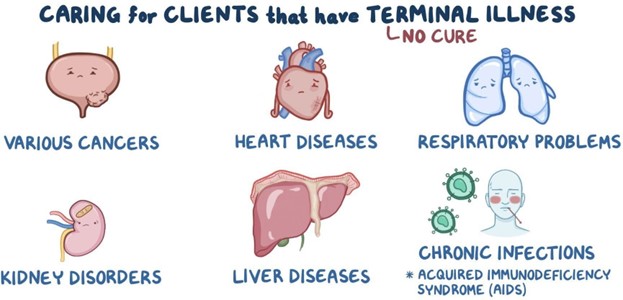The practical nurse (PN) should collect the following information during the admission assessment of a terminally ill client to an acute care facility:
Health care proxy documentation
Name of funeral home to contact
Client's wishes regarding organ donation
Contact information for the client's next of kin
The Correct Answer is A
The correct answer and explanation is:
a) Health care proxy documentation.
This is the information that the PN should collect during the admission assessment of a terminally ill client to an acute care facility. Health care proxy documentation is a legal document that appoints a person to make health care decisions for the client when they are unable to do so themselves. It is important to have this information in case the client's condition deteriorates and they need end-of-life care.
b) Name of funeral home to contact.
This is not the information that the PN should collect during the admission assessment of a terminally ill client to an acute care facility. Name of funeral home to contact is a personal preference that may or may not be relevant for the client at this point. It is not a priority for the admission assessment, and it may be insensitive or inappropriate to ask the client about it.
c) Client's wishes regarding organ donation.
This is not the information that the PN should collect during the admission assessment of a terminally ill client to an acute care facility. Client's wishes regarding organ donation are a personal choice that may or may not be applicable for the client depending on their diagnosis, prognosis, and eligibility. It is not a priority for the admission assessment, and it may be offensive or upsetting to ask the client about it.
d) Contact information for the client's next of kin.
This is not the information that the PN should collect during the admission assessment of a terminally ill client to an acute care facility. Contact information for the client's next of kin is a general demographic data that may or may not be relevant for the client's care. It is not a priority for the admission assessment, and it may be already available in the client's records.
 |
Nursing Test Bank
Naxlex Comprehensive Predictor Exams
Related Questions
Correct Answer is D
Explanation
Choice A rationale:
Checking the client's temperature is important for assessing the client's condition, but it is not a priority before administering penicillin G IV for meningitis.
Choice B rationale:
Assessing the client's level of consciousness is essential for monitoring neurological status, but it is not the highest priority action before administering penicillin G IV for meningitis.
Choice C rationale:
Asking the client about any history of allergies is important for assessing potential allergic reactions to medications. However, the most critical action before administering penicillin G IV for meningitis is to obtain a blood sample for culture and sensitivity. This action helps identify the causative organism and guides appropriate antibiotic therapy, as meningitis can be life-threatening and requires prompt treatment.
Choice D rationale:
Obtaining a blood sample for culture and sensitivity is the highest priority action before administering penicillin G IV for meningitis. Identifying the specific pathogen responsible for the infection is crucial for selecting the most effective antibiotic therapy and preventing complications.
Correct Answer is D
Explanation
Choice A rationale:
Aspirin is not typically contraindicated in a client who has taken sildenafil unless there are specific contraindications or allergies. Aspirin is often used in the management of acute chest pain to help prevent blood clot formation.
Choice B rationale:
Heparin is not contraindicated solely because the client has taken sildenafil. Heparin is an anticoagulant commonly used in various clinical settings, including the management of certain cardiac conditions.
Choice C rationale:
Morphine is not necessarily contraindicated based solely on the client's use of sildenafil. Morphine can be used to relieve chest pain in some cases of acute coronary syndrome. However, its use should be carefully evaluated based on the client's overall clinical presentation.
Choice D rationale:
Nitroglycerin should be withheld in this scenario. Sildenafil is a medication used to treat erectile dysfunction and pulmonary arterial hypertension. It can potentiate the vasodilatory effects of nitroglycerin, leading to a severe drop in blood pressure. Concomitant use of nitroglycerin and sildenafil is contraindicated due to the risk of significant hypotension, which can be life-threatening.
Whether you are a student looking to ace your exams or a practicing nurse seeking to enhance your expertise , our nursing education contents will empower you with the confidence and competence to make a difference in the lives of patients and become a respected leader in the healthcare field.
Visit Naxlex, invest in your future and unlock endless possibilities with our unparalleled nursing education contents today
Report Wrong Answer on the Current Question
Do you disagree with the answer? If yes, what is your expected answer? Explain.
Kindly be descriptive with the issue you are facing.
